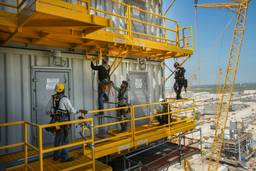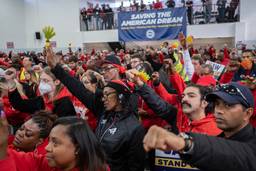
Bogota, COLOMBIA — As Jorge Parra rose to mark down on a sign on the outside of his tent another day of his two-year-long vigil, his mangled body fought back.
Parra’s back is stiff as a metal plank; his left foot nearly paralyzed. He blames the crippling injuries to his arms and spine from the day-to-day scars of working conditions in the General Motors plant in Bogota, where he worked for seven years until he was fired in 2011.
Parra wasn’t the only injured worker let go. In May 2011, he and 67 other ex-GM workers formed a group called the Association of Injured Workers and Ex-Workers of General Motors Colombia (ASOTRECOL). They charged that GM had fired workers injured on the job so it would not have to assume the costs of their healthcare. In August, the workers launched a tent encampment outside the U.S. embassy in Bogota, pledging to remain there until they received a just settlement from GM.
A GM spokesperson told In These Times that the workers had been fired for various reasons, and that the company does not comment on personnel matters.
“When we first came here, they thought we would be here for a week. But we’re here for two years already, and we’ve shown that we have the determination not to give up,” declares Parra, a former worker at a General Motors plant in Bogota.
During their long vigil, the workers have waged multiple hunger strikes in hopes of wringing a settlement from GM. Their struggle has caught the attention of U.S.-based union, human rights activists and religious leaders, who have implored GM to resolve the dispute with the workers.
The workers have also called for intervention from the U.S. government, citing its controlling stake in GM, which received $50 billion in federal bailout money, as well as the recent approval of a bilateral free trade agreement between the United States and Colombia.
The agreement drew the ire of labor activists when it was first proposed in 2006, and passed Congress in 2011 only after U.S. and Colombian negotiators reached a detailed plan for labor protections. But unions and other observers were still doubtful, questioning whether the government of Colombia — dubbed by the AFL-CIO’s Solidarity Center the most dangerous place in the world for trade unionists — would or could live up to its promises.
Among other things, the government promised to protect workers against violence and prosecute their attackers. But the plight of Parra and his colleagues, who have tried unsuccessfully for more than two years to win compensation in Colombian courts, suggests that many of the problems persist.
False unions
A major goal of the free trade agreement’s labor protections was to bolster Colombia’s badly battered labor unions, whose ranks have fallen to only 4 percent of the workplace, down from about 15 percent two decades ago.
Violence against unionists has been a driving force in unions’ downward spiral. Since 1986, more than 2,900 union members have been killed and 12,000 threats have made against union members, according the National Labor Academy in Medellin, a reliable source for labor information in Colombia.
Though the murders of union members have markedly declined in the last few years, threats and attacks on union members jumped by about 50 percent in the last year, especially for those trying to assert the trade agreement’s promises for workers, say officials with the National Labor Academy.
But equally destructive has been the use of sham labor agreements — which workers cannot negotiate and are forced to accept if they want to keep their jobs — to undermine unions.
Such “collective pacts” are the legacy of right-wing governments that have bowed to business interests. Over 227,000 Colombian workers were covered by collective pacts in 2011, according to the U.S. Department of Labor. The sham agreements have been fiercely condemned by Colombian unions and strongly criticized by the International Labor Organization, but continue to be imposed on workers nonetheless.
At the GM plant in Bogota, the independent union that led a strike in the late 1990s was soon undermined by a company-favored collective pact, according to Parra. “They said, ‘You must sign with the collective pact and if you don’t, you won’t work here,’” said Parra, recalling his first days on the job in 2004.
The original union has since shrunk to only a few members, and the collective pact represents the majority of the plant’s workers, a fact confirmed by GM officials in Detroit.
Workers at the plant suffered under the company union. Several years after starting work as a welder, Parra said his arms and back began to ache. “I would go to the GM medical center, and they would say it’s okay and give me an injection for relief,” he recalled. Ultimately, he had operations on his spine and arms, but his medical woes were not relieved.
Parra brought his medical problems to the heads of the collective at the plant, but his complaints fell on deaf ears. “They basically worked for the company. They were not workers like us,” Parra said.
As part of the free trade agreement, Colombia passed a law in 2011 imposing fines on companies that use collective pacts to undermine unions. But the AFL-CIO says that the law is too weak to be enforced. A 2012 study by the National Labor Academy found no convictions under the law to date.
“I don’t think the government doesn’t want to solve the problem. But you have structural problems related to 50 years of civil war,” suggested Todd Howland, Representative of the UN High Commissioner for Human Rights in Colombia. “Colombia is very good at passing laws and regulations and it has a problem making them real throughout the country.”
The free trade deal also spurred Colombia to pass laws requiring recognition of independent unions, but companies have found ways around them. Rather than deal directly with their workers, companies are “employ[ing] workers under fraudulent schemes,” according to an April report by the Trade Union Advisory Committee for Organization for Economic Cooperation and Development.
The U.S. State Department’s 2012 global human rights report acknowledges the troubled state of labor rights in Colombia.
“Employers continued to use temporary contracts, service agencies, and CTAs to limit worker rights and protections and lower costs…In practice fines assessed by the government did little to dissuade violators,” the report notes.
In comparison, U.S. officials from the Department of Labor and the Office of the US Trade Representative in Washington, D.C, who would only speak on background, were generally positive about the state of labor practices in Colombia.
“The Colombians have successfully met the milestones,” said one official, referring to the provisions laid out in the trade agreement regarding unions and workers. U.S. officials hear the unions’ complaints and are “engaged” with the Colombians about them, the official added.
Colombian labor officials readily concede that workers have been victims of violence and abusive labor practices, including shell labor organizations. But they insist that change in these areas is gradual, and that many improvements have already been made.
“We have a long way to go, but we’ve gone beyond anyone before,” said Alfonso Cuellar, Colombia’s deputy chief of mission in Washington, D.C.
Colombia’s Labor Ministry touts the fact that it spent $111 million on protection efforts for union members last year, and has leveled 2,348 fines against labor law violators in 2013. By 2014, the ministry plans to boost the number of workplace inspectors by 44 percent.
Negotiating setbacks
Parra, for his part, sees little change.
A year after the former GM workers launched their encampment in August 2011, the ranks of protesters had dropped to 13. Nothing had changed. They had massive debts. Some had lost their homes. Despair overcame many. Money raised by U.S. union members barely helped. Depression haunted Parra. “I’d get out of bed and there would be no food.” His marriage collapsed.
In desperation, the workers decided to sew their lips shut and launch a hunger strike. Their 28-day fast had quick results. GM officials from Detroit along with US mediators came to Bogota to negotiate in August 2012.
But the talks collapsed with no results.
The 13 workers were demanding retraining for different jobs at the plant, as well as $5.5 million to the cover their medical costs. Instead, the company offered $3,000 initially and then $35,000 for each worker, according to Parra.
ASOTRECOL declined the offer, insisting that they should receive the same compensation from GM as U.S. workers injured on the job. Typically, completely disabled workers can receive up to two-thirds of their salary for their lifetime in the U.S., according to workplace compensation attorneys. The money offered by GM to ASOTRECOL workers “wouldn’t come close to covering our health problems,” said Parra.
GM counters that it made a number of offers during the negotiations. One totaled $150,000 in programs for the workers and their families. Another would have provided 15 months of salary, health care and pension benefits and two years of higher education costs, according to McBride.
The workers have also fought GM in Colombian courts, seeking compensation for their injuries and challenging their dismissals. By GM’s reckoning, it has won in 25 out of 29 cases filed by the workers. Four are pending.
In June, the workers thought they had made a breakthrough when a Ministry of Labor official ordered the workers’ case to be reopened regarding health and safety records, workplace procedures and government investigations at the plant. A government inspector for the plant previously was sanctioned for failing to do his work properly.
Much to their surprise, however, the investigator shelved the case in July. “It’s clear what happened. The company talked to the Minister and he told her (the investigator) to back off,” claimed Rhett Doumitt, head of the AFL-CIO’s Solidarity Center in Bogota.
ASOTRECOL decided to try another dramatic gesture, and planned to symbolically crucify one of their ranks on a cross in front the embassy. Eager to avert a crisis, local government officials agreed to help restart negotiations in mid-August, but nothing came from the gesture. GM officials merely repeated the company’s prior offer, according to Doumitt, whose office has closely followed the GM workers’ struggle. GM officials confirmed that the meeting failed to produce any results.
Frank Hammer, a retired UAW local president and GM worker from Detroit, is one of the union, religion and human rights activists, who have embraced the workers’ cause. During a recent visit to Bogota, he listened as the wondered what to do after all their setbacks they’ve suffered.
Hammer believes ASOTRECOL’s struggle is crucial both for Colombian workers and for American ones, whom he says could one day face the same struggle — suffering workplace injustices without anyone speaking up for them.
The fight is still an uphill one, but Hammer is encouraged by the way that the workers have dug in. “If we can blow our horns a little louder,” he says, “then maybe they (GM) will change their thinking about a settlement.”
The Pulitzer Center for Crisis Reporting supported this reporting.
A former labor writer for the Chicago Tribune, Stephen Franklin is a Pulitzer Prize finalist and an adjunct professor at the University of Illinois Urbana-Champaign School of Labor and Employment Relations.




